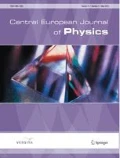Abstract
We classify six-dimensional F-theory compactifications in terms of simple features of the divisor structure of the base surface of the elliptic fibration. This structure controls the minimal spectrum of the theory. We determine all irreducible configurations of divisors (“clusters”) that are required to carry nonabelian gauge group factors based on the intersections of the divisors with one another and with the canonical class of the base. All 6D F-theory models are built from combinations of these irreducible configurations. Physically, this geometric structure characterizes the gauge algebra and matter that can remain in a 6D theory after maximal Higgsing. These results suggest that all 6D supergravity theories realized in F-theory have a maximally Higgsed phase in which the gauge algebra is built out of summands of the types su(3), so(8), f4, e6, e8, e8, (g2 ⊕ su(2)); and su(2) ⊕ so(7) ⊕ su(2), with minimal matter content charged only under the last three types of summands, corresponding to the non-Higgsable cluster types identified through F-theory geometry. Although we have identified all such geometric clusters, we have not proven that there cannot be an obstruction to Higgsing to the minimal gauge and matter configuration for any possible F-theory model. We also identify bounds on the number of tensor fields allowed in a theory with any fixed gauge algebra; we use this to bound the size of the gauge group (or algebra) in a simple class of F-theory bases.
Similar content being viewed by others
References
A. Grassi, D.R. Morrison, arXiv:math/0005196
V. Kumar, W. Taylor, arXiv:0906.0987 [hep-th]
V. Kumar, W. Taylor, arXiv:0910.1586 [hep-th]
V. Kumar, D.R. Morrison, W. Taylor, arXiv:0911.3393 [hep-th]
V. Kumar, D.R. Morrison, W. Taylor, arXiv:1008.1062 [hep-th]
V. Kumar, D. Park, W. Taylor, arXiv:1011.0726 [hepth]
N. Seiberg, W. Taylor, arXiv:1103.0019 [hep-th]
D.R. Morrison, W. Taylor, arXiv:1106.3563 [hep-th]
A. Grassi, D.R. Morrison, arXiv:1109.0042 [hep-th]
V. Braun, arXiv:1110.4883 [hep-th]
D.S. Park, W. Taylor, arXiv:1110.5916 [hep-th]
D.S. Park, arXiv:1111.2351 [hep-th]
F. Bonetti, T.W. Grimm, arXiv:1112.1082 [hep-th]
C. Vafa, arXiv:hep-th/9602022
D.R. Morrison, C. Vafa, arXiv:hep-th/9602114
D.R. Morrison, C. Vafa, arXiv:hep-th/9603161
A. Grassi, Math. Ann. 290, 287 (1991)
M. Gross, Duke Math. Jour. 74, 271 (1994)
M.J. Duff, R. Minasian, E. Witten, arXiv:hep-th/9601036
N. Seiberg, E. Witten, arXiv:hep-th/9603003
A. Sagnotti, arXiv:hep-th/9210127
V. Sadov, arXiv:hep-th/9606008
P. Candelas, E. Perevalov, G. Rajesh, arXiv:hep-th/9704097
P. S. Aspinwall, D.R. Morrison, arXiv:hep-th/9705104
D.R. Morrison, W. Taylor, to appear
D.R. Morrison, arXiv:hep-th/0411120
F. Denef, arXiv:0803.1194 [hep-th]
W. Taylor, arXiv:1104.2051 [hep-th]
J. de Boer et al., arXiv:hep-th/0103170
P.S. Aspinwall, D.R. Morrison, arXiv:hep-th/9805206
K. Kodaira, Ann. Math. 77, 563 (1963)
K. Kodaira, Ann. Math. 78, 1 (1963)
M. Bershadsky et al., arXiv:hep-th/9605200
S. Katz, D.R. Morrison, S. Schafer-Nameki, J. Sully, arXiv:1106.3854 [hep-th]
S.H. Katz, C. Vafa, arXiv:hep-th/9606086
M. Esole, S.-T. Yau, arXiv:1107.0733 [hep-th]
M. Esole, J. Fullwood, S.-T. Yau, arXiv:1110.6177 [hep-th]
C. Cordova, arXiv:0910.2955 [hep-th]
S. Kachru, C. Vafa, arXiv:hep-th/9505105]
K.A. Intriligator, arXiv:hep-th/9708117]
U.H. Danielsson, P. Stjernberg, arXiv:hep-th/9603082
M. Demazure, H.C. Pinkham, B. Teissier, eds., Seminaire sur les singularités des surfaces, Lecture Notes in Math. vol. 777 (Springer, 1980)
H.C. Pinkham, Simple elliptic singularities, Del Pezzo surfaces and Cremona transformations, Proc. Sympos. Pure Math., Vol. XXX, Part 1, 69 (Amer. Math. Soc., 1977)
Author information
Authors and Affiliations
Corresponding author
About this article
Cite this article
Morrison, D.R., Taylor, W. Classifying bases for 6D F-theory models. centr.eur.j.phys. 10, 1072–1088 (2012). https://doi.org/10.2478/s11534-012-0065-4
Received:
Accepted:
Published:
Issue Date:
DOI: https://doi.org/10.2478/s11534-012-0065-4



